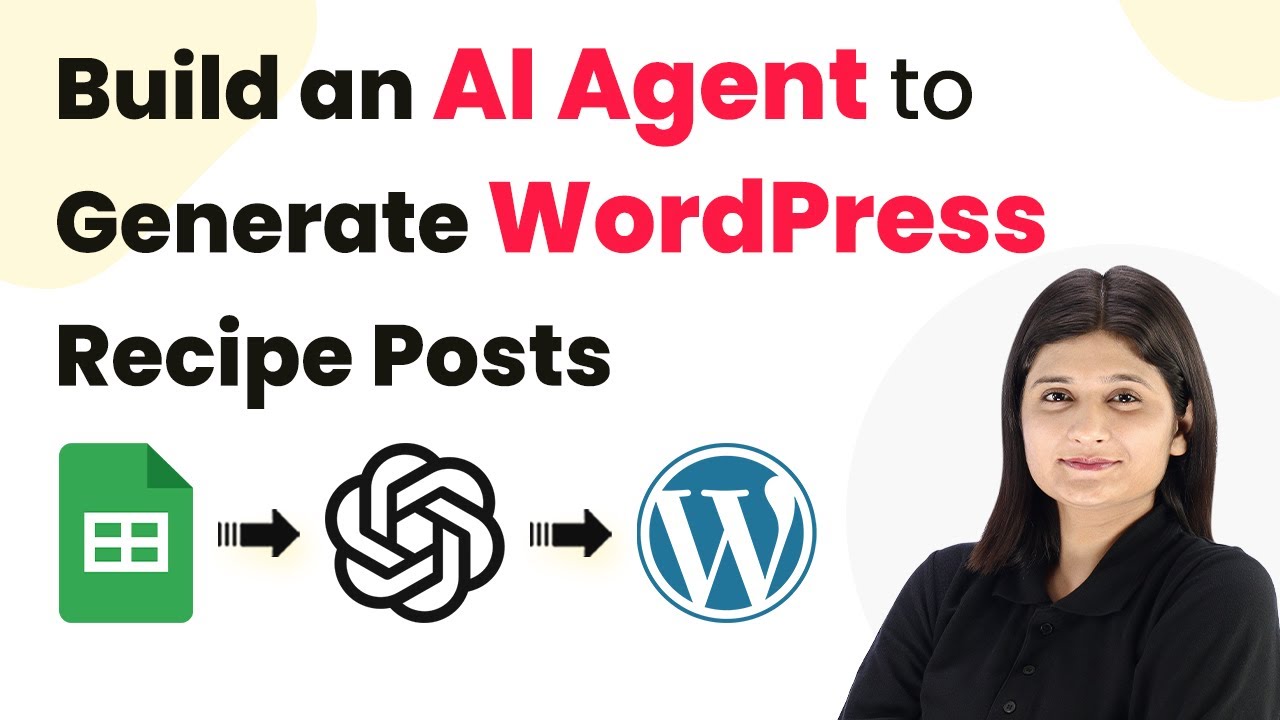Blog
How to Build an AI Agent to Auto-Generate WordPress Recipe Posts

Introduction to AI-Powered Recipe Generation
In today’s digital world, content creation is evolving rapidly, and leveraging artificial intelligence (AI) can greatly enhance efficiency and creativity. One exciting application of AI is in the realm of recipe blogging. Whether you’re a culinary expert or a food enthusiast, automating the generation of WordPress recipe posts can save time while maintaining high-quality content. This guide will take you through the essential steps to create an AI agent that can auto-generate recipe posts for your WordPress site.
Understanding AI in Content Creation
AI technology has made significant strides, enabling machines to perform tasks once thought to be exclusive to humans. When it comes to content creation, AI can analyze vast amounts of data, identify patterns, and generate text in a coherent and contextually relevant manner. This means that you can produce articles, including recipes, that are engaging and informative by harnessing the power of AI.
Step 1: Define Your Objectives
Before diving into the technical aspects of building an AI agent, it’s crucial to define your objectives. Ask yourself the following questions:
- What type of recipes do you want to generate (e.g., vegan, gluten-free, quick meals)?
- Who is your target audience?
- How frequently do you wish to publish new content?
Clearly outlining your goals will inform the rest of the development process.
Step 2: Choose the Right AI Model
Selecting an appropriate AI model is vital for the success of your automated recipe generation. There are various AI models available, but for generating text-based content, models like GPT-3 (or its successors) are particularly effective.
Considerations When Choosing a Model
- Training Data: The model should have been trained on a diverse dataset that includes culinary topics.
- Customizability: Look for a model that allows you to fine-tune its parameters to align with your specific needs.
- Integration: Ensure that the model can be easily integrated with your selected platforms and technologies.
Step 3: Gather and Prepare Your Data
To train or fine-tune your AI model, you will need a substantial amount of data. This data can come from various sources:
- Existing Recipes: Collect existing recipes from reputable culinary websites, cookbooks, and blogs.
- User-Generated Content: Consider integrating reviews or feedback from home cooks to enhance recipe authenticity.
- Nutritional Information: Make sure to include detailed nutritional information for each recipe.
Cleaning the Data
Data preparation is crucial. Clean the data by removing duplicates, correcting inaccuracies, and formatting it uniformly. This will ensure that your AI model learns effectively.
Step 4: Develop the AI Agent
With your data ready and an AI model chosen, it’s time to develop your AI agent. This involves coding and implementation, typically using programming languages like Python.
Overview of Workflow
- Data Input: Create a system where you can upload or input your recipe data easily.
- Text Generation: Use the AI model to generate recipe content based on the input data.
- Quality Control: Set up a review mechanism where human editors can evaluate the generated content for quality and accuracy.
Testing Your Agent
Once your AI agent is developed, conduct rigorous testing. Generate a sample of recipes and evaluate them based on the following criteria:
- Consistency in style and format
- Logical flow of ingredients and instructions
- Accessibility of language for your target audience
Step 5: Integrating with WordPress
To automate your recipe publishing process, you need to integrate your AI agent with your WordPress site. This typically involves using the WordPress REST API or similar frameworks.
Steps for Integration
- Authenticate Your API: Ensure that your API is securely configured for seamless interaction with WordPress.
- Automate Posting: Develop functionality that allows the AI agent to upload generated recipes directly to your WordPress dashboard.
- SEO Optimization: Incorporate SEO best practices in your posts, such as optimized titles, keywords, and meta descriptions.
Step 6: Monitor and Optimize
Launching your AI-powered recipe generator is just the beginning. Continuous monitoring and optimization are essential for maintaining quality and relevance.
Key Performance Indicators (KPIs) to Track
- Engagement Rates: Monitor how users interact with the generated recipes (likes, comments, shares).
- Traffic Analytics: Use tools like Google Analytics to assess how the AI-generated content drives traffic to your site.
- User Feedback: Encourage user feedback on the recipes to enhance future iterations of your AI agent.
Ethical Considerations
As you deploy an AI agent for recipe generation, it is important to uphold ethical standards. Ensure that the content produced is original and does not infringe on copyrights. Address concerns around the authenticity of recipes by providing clear sourcing and allowing user input.
Future Trends in AI Content Creation
As technology continues to advance, the capabilities of AI in content generation will expand. Future trends you may consider exploring include:
- Machine Learning Enhancements: Utilizing machine learning to improve the accuracy and quality of generated recipes continuously.
- Personalization: Tailoring content to the preferences of individual users based on historical data and interactions.
- Multimedia Integration: Incorporating images and videos alongside text to create a richer user experience.
Conclusion
Building an AI agent to auto-generate WordPress recipe posts is a transformative approach that can elevate your culinary blog while saving you time and effort. With proper planning, data preparation, and continuous optimization, you can create high-quality content that resonates with your audience. Embrace the potential of AI and watch your recipe blog flourish like never before.

